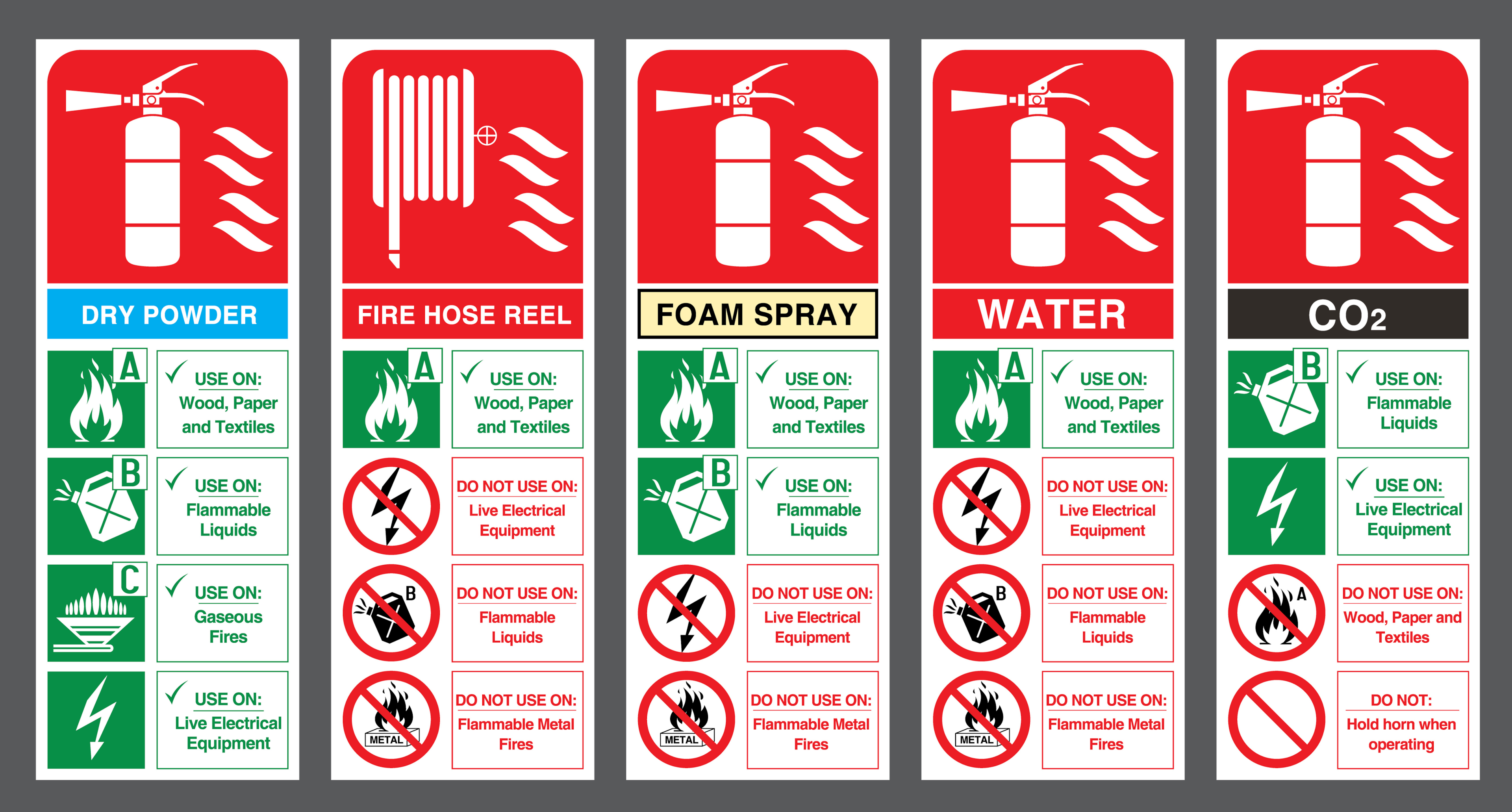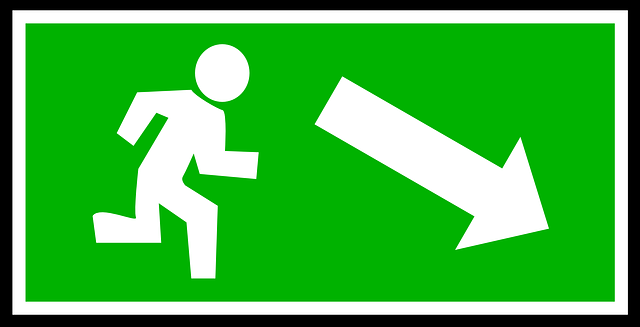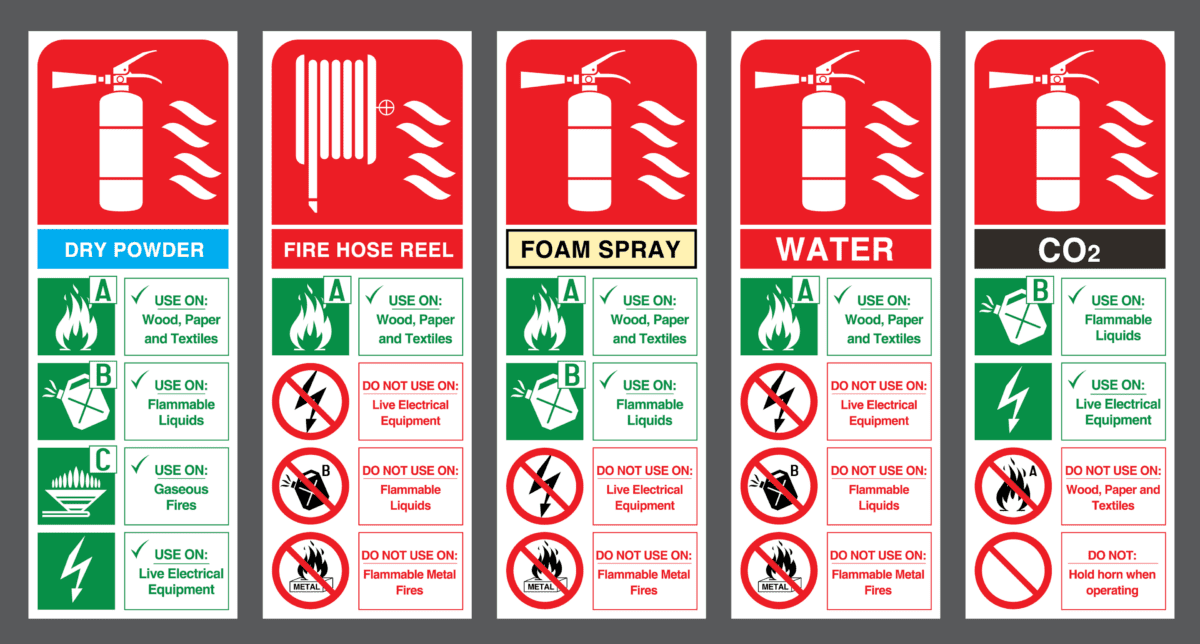When it comes to fire safety, having the right equipment and having the right knowledge is critical. It can make the difference between a minor incident and a devastating disaster. One essential tool that plays a crucial role in fire prevention and control is the fire extinguisher. In the UK, fire extinguishers are color-coded. In this ‘How to use what colour fire extinguisher UK’ article we will take a look at the meaning behind fire extinguisher colours.
Fire extinguishers in the UK are classified according to their contents, which are identified by specific colours.
The colour coding system for fire extinguishers plays a crucial role in quickly identifying the appropriate type of fire extinguisher for a given type of fire.
By being aware of the colour code, individuals can select the correct fire extinguisher types and effectively combat a fire without wasting precious time.
The Different Types of Fire Extinguishers – Fire Extinguisher Colours

The five fire extinguisher colours:
Red
Red fire extinguishers typically contain water and are suitable for fires involving ordinary combustible materials, such as wood, paper, or cloth.
Water fire extinguishers work by cooling the fire and reducing the temperature below its ignition point.
Red fire extinguishers are commonly found in residential and commercial settings, providing a reliable and effective means of extinguishing fires caused by common combustible materials.
Blue
Blue fire extinguishers usually contain dry powder and are suitable for fires involving flammable liquids, such as gasoline, oil, or solvents.
These extinguishers work by smothering the fire and interrupting the chemical reaction necessary for combustion.
Cream
Cream-colored fire extinguishers contain foam and are effective against fires caused by flammable liquids and solid materials.
The cream color distinguishes them from other extinguishers and indicates their ability to create a foam blanket that suppresses the fire, preventing oxygen from reaching the fuel source and extinguishing the flames.
Black
Black fire extinguishers contain carbon dioxide (CO2) and are suitable for fires involving electrical equipment and flammable liquids.
Carbon dioxide works by displacing oxygen, effectively suffocating the fire and suppressing its ability to burn.
Yellow
Yellow fire extinguishers are filled with a wet chemical solution and are ideal for fires fuelled by cooking oils and fats, commonly found in kitchens and restaurants. T
he yellow colour of a wet chemical fire extinguisher distinguishes them from other extinguishers and indicates their effectiveness in rapidly cooling the fire and creating a soapy layer that prevents re-ignition.
Safety Precautions Before Using a Fire Extinguisher
Before attempting to use a fire extinguisher, remember these important safety precautions:
- Assess the situation: Evaluate the size and nature of the fire. If the fire is large or spreading rapidly, evacuate immediately and call the fire department. It is crucial to prioritize your safety and the safety of others.

- Ensure an escape route: Always position yourself with a clear and safe path to exit in case the fire becomes uncontrollable. Being prepared with an escape plan can help you stay calm and focused during a fire emergency.

- Communicate: Inform others in the area about the fire and your intention to fight it with an extinguisher. Clear communication can prevent panic and ensure that everyone is aware of the situation at hand.
Now that we have established the necessary safety precautions, let’s move on to the step-by-step process of using a fire extinguisher effectively.
Choosing what Color Fire Extinguisher for what Fire
Having a clear understanding of fire classes and the corresponding extinguishers is crucial to ensure the correct choice of equipment in various fire scenarios. Don’t leave it till you are in a smoke filled room to understand this!
When it comes to fire safety, one size does not fit all. Different types of fires require different types of extinguishers.
Understanding the fire classes and their corresponding extinguishers can make all the difference in effectively combating a fire and preventing further damage.
It is important to note that using the wrong type of extinguisher can worsen the fire or pose additional risks. Therefore, it is crucial to choose the appropriate extinguisher.
Fire Types
Wood paper & cloth combustible material fires [ known as Class A fires] require a water or foam fire extinguisher. These extinguishers work by cooling the fire and smothering it, effectively cutting off the oxygen supply.
Flammable liquid fires [known as Class B fires] such as petrol, oil, and solvents require dry powder or foam extinguishers. Dry powder extinguishers work by interrupting the chemical reaction of the fire, while foam extinguishers create a barrier between the fuel and the oxygen, suffocating the fire.
Electrical fires or electrical equipment fires [known as Class C Fires] require a Carbon dioxide fire extinguisher (CO2 Fire extinguisher) or dry powder fire extinguishers to avoid conducting electricity. CO2 extinguishers displace the oxygen, effectively smothering the fire, while dry powder extinguishers work by interrupting the chemical reaction.
Fires involving flammable metals [Known as Class D Fires] such as lithium and magnesium require specialized extinguishing agents specifically designed for metal fires. These extinguishers work by creating a layer of insulation on top of the burning metal, preventing the fire from spreading.
Fires fuelled by cooking oils and fats, often kitchen fires [known as Class F fires] demand wet chemical fire extinguishers, specially formulated to combat these types of fires. Wet chemical extinguishers create a cooling effect on the fire and form a soapy layer that prevents re-ignition.
The PASS Technique: Pull, Aim, Squeeze, Sweep
When using a fire extinguisher, remember the PASS technique:
- Pull: Pull the pin located at the top of the extinguisher. This action breaks the tamper seal and allows the extinguisher to discharge. It is important to grip the extinguisher firmly while pulling the pin to ensure a smooth and swift motion.
- Aim: Aim the nozzle or hose at the base of the fire where the fuel source is located. This helps to smother the flames effectively. Take a moment to assess the direction and intensity of the fire before aiming the extinguisher to maximize its impact.
- Squeeze: Squeeze the handle or lever to release the extinguishing agent and start the firefighting process. Maintain a steady grip on the handle while applying pressure to ensure a consistent flow of the extinguishing agent.
- Sweep: Sweep from side to side, directing the extinguishing agent across the base of the fire until it is completely out. This sweeping motion helps to cover a larger area and ensures that no hidden flames reignite. Continue sweeping until the fire is fully extinguished and there is no risk of re-ignition.
Remember, practice makes perfect. Familiarize yourself with the PASS technique by participating in fire safety drills or training sessions.
Being prepared and confident in your ability to use a fire extinguisher can make a significant difference during an emergency situation.
Regular Inspection for Optimal Performance

Perform the following checks on a regular basis:
- Physical condition: Check for damage, corrosion, or leakage in the extinguisher’s body or components.
- Pressure gauge: Ensure the pressure gauge indicates the extinguisher is within the designated range.
- Operating instructions: Make sure the operating instructions on the extinguisher are clear and legible.
When and How to Replace Your Fire Extinguisher
Fire extinguishers have a limited lifespan and must be replaced when they no longer meet the required standards. Here are some signs indicating the need for replacement:
- Expired or damaged: Replace any extinguisher that has exceeded its expiry date or shows signs of damage.
- Loss of pressure: If the pressure gauge is continuously in the red zone or indicates a loss in pressure, replace the extinguisher.
- Inoperable parts: If any part of the extinguisher, such as the hose or nozzle, is damaged or non-functional, it’s time for a replacement.
Legal Requirements for Fire Extinguishers in the UK
Ensuring compliance with fire safety regulations is of utmost importance to protect lives and property.
Compliance with UK Fire Safety Regulations
The Regulatory Reform (Fire Safety) Order 2005 encompasses the regulations and requirements for fire safety in the UK. It is crucial for all businesses and premises to adhere to these regulations.
Penalties for Non-Compliance with Fire Safety Laws
Failure to comply with fire safety laws can result in severe penalties, including fines and imprisonment. The potential risks far outweigh any shortcuts in fire safety compliance.
To Sum Up
In conclusion, understanding the colour coding system for fire extinguishers in the UK is essential for effective fire prevention and control.
Knowing the correct steps to use a fire extinguisher, choosing the right of fire extinguisher colour codes for different fire classes, and maintaining and inspecting extinguishers regularly are all necessary for optimal fire safety.
Understanding the colour code of fire extinguishers is essential for everyone’s safety. By knowing the specific meaning behind each colour, individuals can confidently select the appropriate extinguisher and take immediate action in the event of a fire.
The Brightchecker App
Check out the Brightchecker App for Fire Inspections – already in use for over a year with our subscribers who save time, identify remedial works, and create a great report every time.
Additional Reading
More Helpful Content
Visit our Homepage

